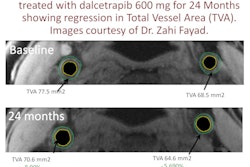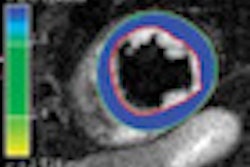Results from the Multi-Ethnic Study of Atherosclerosis (MESA) show that fat around the heart as detected by cardiac MRI and CT can promote atherosclerosis, according to a paper published online August 16 in Radiology.
The study, funded by the U.S. National Institutes of Health (NIH), concluded that pericardial fat is more strongly related to coronary artery plaque than either body mass index (BMI) or waist circumference. The lead author of the study is Dr. Cuilian Miao, from the department of radiology at Northwestern University Medical School.
Plaque deposits irregularly in the arteries, thickening the artery wall on one side but not the other. The ratio of the thick side to the thin side is referred to as plaque eccentricity and has proved to be a strong indicator of heart disease.
Previous studies have looked at the relationship of pericardial fat to atherosclerosis in patients with severe coronary disease; however, this is the first study to determine the association of pericardial fat and coronary artery plaque burden in asymptomatic individuals, according to the researchers.
From October 2005 to February 2008, the study enrolled 225 participants, eventually including 183 (89 women and 94 men; mean age, 61 years) with no symptoms of cardiovascular disease and who were otherwise healthy. While the majority of individuals were overweight, they did not have significant coronary artery narrowing -- yet coronary plaque was still detected by MRI, said senior author Dr. David Bluemke, PhD, director of radiology and imaging sciences at NIH Clinical Care.
The researchers used MRI to evaluate coronary artery eccentricity as a measure of early-stage atherosclerosis and CT to determine pericardial fat volume.
The results showed that pericardial fat volume correlated significantly with the degree of plaque eccentricity (p < 0.05) in both men and women. After adjustments for BMI, waist circumference, traditional risk factors, C-reactive protein level, and coronary artery calcium content, the relationship between pericardial fat and plaque eccentricity remained significant in men (p < 0.01) but not in women.
BMI and waist circumference also correlated with the degree of plaque eccentricity in the univariate model (p < 0.05), but not after adjusting for pericardial fat volume or traditional risk factors.
"The findings indicate yet another reason that obesity is bad for us," Bluemke said. "It is particularly bad when the fat forms around the heart, since the heart fat appears to further promote coronary artery plaque."



















